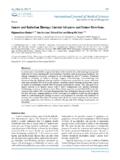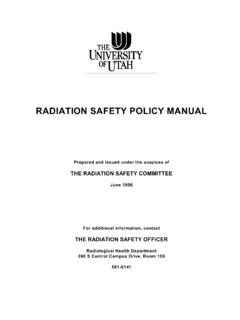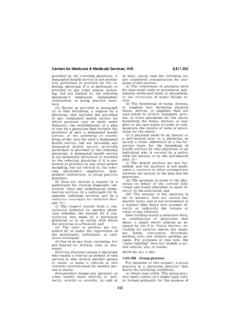Transcription of Ivyspring International Publisher Jo ouurnall off …
1 Journal of Cancer 2012, 3 32 JJoouurrnnaall ooff ccaanncceerr 2012; 3: 32-41. doi: Research Paper Properties of Lewis Lung Carcinoma Cells Surviving Curcumin Toxicity Dejun Yan1, Michael E. Geusz1, and Roudabeh J. Jamasbi1,2 1. Department of Biological Sciences, Bowling Green State University, Bowling Green, OH 43403, USA 2. Department of Public and Allied Health, Bowling Green State University, Bowling Green, OH 43403, USA Corresponding author: Roudabeh Jamasbi, PhD, Department of Public and Allied Health, Department of Biological Sciences, 204 Life Sciences Building, Bowling Green State University, Bowling Green, OH 43403. (419) 372-8724; Fax: 419-372-2024; Email: Ivyspring International Publisher .
2 This is an open-access article distributed under the terms of the Creative Commons License ( licenses/by-nc- ). Reproduction is permitted for personal, noncommercial use, provided that the article is in whole, unmodified, and properly cited. Received: ; Accepted: ; Published: Abstract The anti-inflammatory agent curcumin can selectively eliminate malignant rather than normal cells. The present study examined the effects of curcumin on the Lewis lung carcinoma (LLC) cell line and characterized a subpopulation surviving curcumin treatments. Cell density was measured after curcumin was applied at concentrations between 10 and 60 M for 30 hours. Because of the high cell loss at 60 M, this dose was chosen to select for surviving cells that were then used to establish a new cell line.
3 The resulting line had approximately 20% slower growth than the original LLC cell line and based on ELISA contained less of two markers, NF- B and ALDH1A, used to identify more aggressive cancer cells. We also injected cells from the original and surviving lines subcutaneously into syngeneic C57BL/6 mice and monitored tumor development over three weeks and found that the curcumin surviving-line remained tumorigenic. Because curcumin has been reported to kill cancer cells more effectively when administered with light, we examined this as a possible way of enhancing the efficacy of curcumin against LLC cells. When LLC cells were exposed to curcumin and light from a fluorescent lamp source, cell loss caused by 20 M curcumin was enhanced by about 50%, supporting a therapeutic use of curcumin in combination with white light.
4 This study is the first to characterize a curcumin-surviving subpopulation among lung cancer cells. It shows that curcumin at a high concentration either selects for an intrinsically less aggressive cell subpopulation or generates these cells. The findings further support a role for curcumin as an adjunct to tradi-tional chemical or radiation therapy of lung and other cancers. Key words: Lewis lung carcinoma, curcumin, cancer stem cell, phototoxicity. Introduction Curcumin, a yellow-orange dye in the spice turmeric, causes selective apoptosis in many cancer cell types including those of small-cell lung cancer while sparing normal cells (1-4). The therapeutic ef-fects of curcumin against carcinogensis and progres-sion of tumor growth depend on its inhibition of multiple intracellular signaling molecules, most nota-bly NF- B that plays a central role in various re-sponses leading to host defense and also inflamma-tion (5-7).
5 Curcumin has been documented in the In-dian medical system Ayurveda for over 6000 years and is still prominent in the diets of Asian countries (8). Although orally administered curcumin is re-markably well tolerated and has been evaluated as a supplemental chemotherapeutic drug, its bioavaila-bility is very poor. Oral administration of curcumin has shown no effect on mammary, liver, kidney (9) or lung cancers (10). Improvements in bioavailability are needed to increase the effectiveness of this promising drug, particularly for targets outside the gastrointes-tinal tract. Alternative therapeutic approaches are to administer curcumin either directly to tumors or through the circulatory system either alone or in combination with more traditional cancer treatments.
6 When administered with radiation (11-16) or chemo-therapy (17-20) curcumin sensitizes the tumor to the Ivyspring International Publisher Journal of Cancer 2012, 3 33 treatment and improves outcome (21, 22). Many cancers return following chemotherapy because of resistant cells. In some cases, resistance has been attributed to cancer stem cells (CSCs), a small subpopulation of self-renewing cells that are thought to be critical for tumor recurrence and progression and that can proliferate after chemotherapy and radi-ation therapy (23, 24). In light of the potential benefits of curcumin delivered in combination with standard cancer therapies, it will be important to characterize cells showing tolerance to curcumin.
7 A few reports have identified the properties of curcumin-surviving subpopulations of tumors or cancer cell lines (25-28). Any examination of curcumin-resistance should con-sider the possible presence of CSCs. In this study, we investigated the effect of cur-cumin on the Lewis lung carcinoma (LLC) cell line. The LLC line is a well-established mouse cancer model that is commonly used as a transplantable ma-lignancy model in syngeneic C57BL/6 mice. We also generated and characterized a curcumin-surviving LLC sub-population and tested its ability to form tu-mors in mice. Finally, we used LLC cells to replicate a reported synergistic effect of light and curcumin on cancer cells as a possible way of increasing the effi-cacy of curcumin.
8 Materials and Methods Animals A transgenic mPer1::luc mouse line that we used previously to produce LLC tumors (29) was bred and maintained in the BGSU Animal Care Facility under standard conditions of 12 hr light:12 hr dark and fed a reduced-fat mouse chow ad libitum. The mice were originally produced by Dr. Hajime Tei of Mitsubishi Kagaku Institute of Life Sciences, Tokyo through oo-cyte injection and were on a C57BL/6 background (30). Although not utilized in this study, these mice contain the firefly luciferase gene luc controlled by the promoter of the mPer1 gene, enabling biolumines-cence imaging of tumor growth (29). The mice re-ceived humane care in accordance with the BGSU Institutional Animal Care and Use Committee (IACUC).
9 Lewis Lung Carcinoma (LLC) cell line The LLC cell line was provided by Dr. Stephen Kennel of the University of Tennessee Medical Center, Knoxville, TN. The cells were cultured in Dulbecco s modified eagle medium (DMEM, GIBCO, Invitrogen, NY), supplemented with penicillin (100 U/ml), streptomycin (100 g/ml) and 5 or 10% fetal bovine serum (FBS, Atlanta Biological, Lawrenceville, GA), referred to here as complete DMEM. The cultured cells were kept in 100-mm tissue culture dishes at 37 C in a humidified atmosphere containing 5% CO2 (31). Curcumin treatment To determine the dose-dependent effect of cur-cumin on LLC cells, the cultured cells were washed, trypsinized, collected, counted using a hemocytome-ter (Hausser Scientific, PA) and subsequently plated in 24-well plates at a density of 5 104 cells/well and incubated at 37 C.
10 Curcumin (purity 70%, Sigma) was dissolved in DMSO, and diluted in complete DMEM to provide a curcumin concentration ranging from 10 to 60 M. Twenty-four hours after plating, each of the four-well columns was washed with PBS once, and each column was exposed to 10, 20, 40 or 60 M cur-cumin. Four wells treated with complete DMEM or complete DMEM with DMSO served as controls. After incubation, the cell density was assayed with the crystal violet staining method according to a standard protocol (32). The resulting absorbance of the stained cells was analyzed with ANOVA (OriginLab, Northampton, MA). The experiment was repeated with 2, 4, 8, 16, 24, or 30 hrs of curcumin exposure using a range of curcumin dosages.















